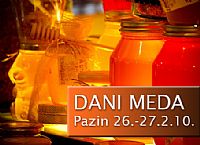 The case with the choice of beekeeper that is honeymaker is the same as with a café and your favourite coffee brand. You choose once and never change. In her time, Empress Maria Theresa proclaimed beekeeping a protected craft. “...In order to popularize beekeeping among our people, it is exempt from any tax or toll for all times...”, stands in the Patent on beekeeping from 1775.
The case with the choice of beekeeper that is honeymaker is the same as with a café and your favourite coffee brand. You choose once and never change. In her time, Empress Maria Theresa proclaimed beekeeping a protected craft. “...In order to popularize beekeeping among our people, it is exempt from any tax or toll for all times...”, stands in the Patent on beekeeping from 1775.
A spoonful of health
Locust tree honey - the best cure for stress; meadow honey - it is difficult to count up all its benefits, but it will do wonders for elderly people and give them new strength; chestnut honey with its bitterness defies the saying 'sweet as honey' but is a great remedy for digestive difficulties and other disorders... Honey is healthy! This is a statement no one will even dare to deny. How healthy it really is, that is something we are yet to find out. But with great certainty and with no reason to prove it we can say for sure that honey has a wonderful taste, it is a special sweetener and is equally good today as it was when man reached for it into the beehive for the very first time (how did he even get this idea?). Istrian honey is of outstanding quality, but there isn't much of it, just as much as there is vegetation. In order to harvest as much honey as possible, beekeepers carry their hives to places even a few hundred kilometres away. This is one of the integral parts of beekeeping.
The long way to honey
In Istria it all begins in April when beekeepers harvest fruit honey and dandelion honey which is extracted until May. Then the hives and beekeepers, like real nomads, move in search of locust trees that yield high quality and delicious honey. At the same time bees are diligently collecting sage nectar. The next activity takes place in June when hives are transferred to areas rich in chestnut trees, which has become a very uncertain and modest source of honey. At this period there is no activity of bees in Istria, so the search for flower blossoms for the nectar takes beekeepers to areas of Gorski kotar, Kordun and Lika. This best speaks of the beekeepers' nomadic way of life and their readiness to cover several hundred kilometres every seven days to reach the faraway hives just for a few kilograms of sweet honey. In mid-September the bees return home. Then they mostly sip the nectar from heather and other plants blossoming at that time. For those who don't know much about honey making and its terminology, honey extraction is the process of removing honey from the honeycomb. So, after the last honey extraction in the year, beekeepers prepare their bees for the winter, leaving enough honey for them to survive - about fifteen kilograms in each hive.